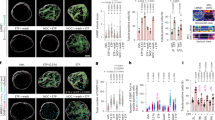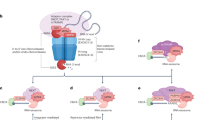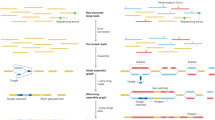Abstract
Nucleosomes are the fundamental subunits of eukaryotic chromatin. They are not static entities, but can undergo a number of dynamic transitions, including spontaneous repositioning along DNA. As nucleosomes are spaced close together within genomes, it is likely that on occasion they approach each other and may even collide. Here we have used a dinucleosomal model system to show that the 147-base-pair (bp) DNA territories of two nucleosomes can overlap extensively. In the situation of an overlap by 44 bp or 54 bp, one histone dimer is lost and the resulting complex can condense to form a compact single particle. We propose a pathway in which adjacent nucleosomes promote DNA unraveling as they approach each other and that this permits their 147-bp territories to overlap, and we suggest that these events may represent early steps in a pathway for nucleosome removal via collision.
This is a preview of subscription content, access via your institution
Access options
Subscribe to this journal
Receive 12 print issues and online access
$189.00 per year
only $15.75 per issue
Buy this article
- Purchase on Springer Link
- Instant access to full article PDF
Prices may be subject to local taxes which are calculated during checkout





Similar content being viewed by others
Accession codes
References
van Holde, K.E. Chromatin, (Springer-Verlag, New York, 1988).
Groth, A., Rocha, W., Verreault, A. & Almouzni, G. Chromatin challenges during DNA replication and repair. Cell 128, 721–733 (2007).
Workman, J.L. Nucleosome displacement in transcription. Genes Dev. 20, 2009–2017 (2006).
Kornberg, R.D. & Lorch, Y. Twenty-five years of the nucleosome, fundamental particle of the eukaryote chromosome. Cell 98, 285–294 (1999).
Davey, C.A., Sargent, D.F., Luger, K., Maeder, A.W. & Richmond, T.J. Solvent mediated interactions in the structure of the nucleosome core particle at 1.9 Å resolution. J. Mol. Biol. 319, 1097–1113 (2002).
Flaus, A., Luger, K., Tan, S. & Richmond, T.J. Mapping nucleosome position at single base-pair resolution by using site-directed hydroxyl radicals. Proc. Natl. Acad. Sci. USA 93, 1370–1375 (1996).
Widlund, H.R. et al. Identification and characterization of genomic nucleosome-positioning sequences. J. Mol. Biol. 267, 807–817 (1997).
Roth, S.Y., Dean, A. & Simpson, R.T. Yeast α2 repressor positions nucleosomes in TRP1/ARS1 chromatin. Mol. Cell. Biol. 10, 2247–2260 (1990).
Strauss, F. & Varshavsky, A. A protein binds to a satellite DNA repeat at three specific sites that would be brought into mutual proximity by DNA folding in the nucleosome. Cell 37, 889–901 (1984).
Pazin, M.J., Bhargava, P., Geiduschek, E.P. & Kadonaga, J.T. Nucleosome mobility and the maintenance of nucleosome positioning. Science 276, 809–812 (1997).
Polach, K.J. & Widom, J. Mechanism of protein access to specific DNA sequences in chromatin: a dynamic equilibrium model for gene regulation. J. Mol. Biol. 254, 130–149 (1995).
Li, G., Levitus, M., Bustamante, C. & Widom, J. Rapid spontaneous accessibility of nucleosomal DNA. Nat. Struct. Mol. Biol. 12, 46–53 (2005).
Ferreira, H., Somers, J., Webster, R., Flaus, A. & Owen-Hughes, T. Histone tails and the H3 αN helix regulate nucleosome mobility and stability. Mol. Cell. Biol. 27, 4037–4048 (2007).
Schalch, T., Duda, S., Sargent, D.F. & Richmond, T.J. X-ray structure of a tetranucleosome and its implications for the chromatin fibre. Nature 436, 138–141 (2005).
Bancaud, A. et al. Nucleosome chiral transition under positive torsional stress in single chromatin fibers. Mol. Cell 27, 135–147 (2007).
Meersseman, G., Pennings, S. & Bradbury, E.M. Mobile nucleosomes—a general behavior. EMBO J. 11, 2951–2959 (1992).
Thastrom, A. et al. Sequence motifs and free energies of selected natural and non-natural nucleosome positioning DNA sequences. J. Mol. Biol. 288, 213–229 (1999).
Dorigo, B., Schalch, T., Bystricky, K. & Richmond, T.J. Chromatin fiber folding: requirement for the histone H4 N-terminal tail. J. Mol. Biol. 327, 85–96 (2003).
Richard-Foy, H. & Hager, G.L. Sequence-specific positioning of nucleosomes over the steroid-inducible MMTV promoter. EMBO J. 6, 2321–2328 (1987).
Ulyanova, N.P. & Schnitzler, G.R. Human SWI/SNF generates abundant, structurally altered dinucleosomes on polynucleosomal templates. Mol. Cell. Biol. 25, 11156–11170 (2005).
Li, G. & Widom, J. Nucleosomes facilitate their own invasion. Nat. Struct. Mol. Biol. 11, 763–769 (2004).
Segal, E. et al. A genomic code for nucleosome positioning. Nature 442, 772–778 (2006).
Yuan, G.C. et al. Genome-scale identification of nucleosome positions in S. cerevisiae. Science 309, 626–630 (2005).
Johnson, S.M., Tan, F.J., McCullough, H.L., Riordan, D.P. & Fire, A.Z. Flexibility and constraint in the nucleosome core landscape of Caenorhabditis elegans chromatin. Genome Res. 16, 1505–1516 (2006).
Albert, I. et al. Translational and rotational settings of H2A.Z nucleosomes across the Saccharomyces cerevisiae genome. Nature 446, 572–576 (2007).
Lee, W. et al. A high-resolution atlas of nucleosome occupancy in yeast. Nat. Genet. 39, 1235–1244 (2007).
Fatemi, M. et al. Footprinting of mammalian promoters: use of a CpG DNA methyltransferase revealing nucleosome positions at a single molecule level. Nucleic Acids Res. 33, e176 (2005).
Allen, M.J. et al. Atomic force microscope measurements of nucleosome cores assembled along defined DNA sequences. Biochemistry 32, 8390–8396 (1993).
Pisano, S., Pascucci, E., Cacchione, S., De Santis, P. & Savino, M. AFM imaging and theoretical modeling studies of sequence-dependent nucleosome positioning. Biophys. Chem. 124, 81–89 (2006).
van Holde, K. & Zlatanova, J. The nucleosome core particle: does it have structural and physiologic relevance? Bioessays 21, 776–780 (1999).
Thoma, F., Koller, T. & Klug, A. Involvement of histone H1 in the organization of the nucleosome and of the salt-dependent superstructure of chromatin. J. Cell Biol. 83, 403–427 (1979).
Polach, K.J. & Widom, J. A model for the cooperative binding of eukaryotic regulatory proteins to nucleosomal target sites. J. Mol. Biol. 258, 800–812 (1996).
Butler, P.J.G. & Thomas, J.O. Dinucleosomes show compaction by ionic strength, consistent with bending of linker DNA. J. Mol. Biol. 281, 401–407 (1998).
Alilat, M., Sivolob, A., Revet, B. & Prunell, A. Nucleosome dynamics IV. Protein and DNA contributions in the chiral transition of the tetrasome, the histone (H3–H4)2 tetramer-DNA particle. J. Mol. Biol. 291, 815–841 (1999).
Tomschik, M., Karymov, M.A., Zlatanova, J. & Leuba, S.H. The archaeal histone-fold protein HMf organizes DNA into bona fide chromatin fibers. Structure 9, 1201–1211 (2001).
Fan, H.Y., He, X., Kingston, R.E. & Narlikar, G.J. Distinct strategies to make nucleosomal DNA accessible. Mol. Cell 11, 1311–1322 (2003).
Flaus, A. & Owen-Hughes, T. Dynamic properties of nucleosomes during thermal and ATP-driven mobilization. Mol. Cell. Biol. 23, 7767–7779 (2003).
Kassabov, S.R., Zhang, B., Persinger, J. & Bartholomew, B. SWI/SNF unwraps, slides and rewraps the nucleosome. Mol. Cell 11, 391–403 (2003).
Lorch, Y., Zhang, M. & Kornberg, R.D. RSC unravels the nucleosome. Mol. Cell 7, 89–95 (2001).
Ulyanova, N.P. & Schnitzler, G.R. Inverted factor access and slow reversion characterize SWI/SNF-altered nucleosome dimers. J. Biol. Chem. 282, 1018–1028 (2007).
Schnitzler, G.R. et al. Direct imaging of human SWI/SNF-remodeled mono- and polynucleosomes by atomic force microscopy employing carbon nanotube tips. Mol. Cell. Biol. 21, 8504–8511 (2001).
Bruno, M. et al. Histone H2A/H2B dimer exchange by ATP-dependent chromatin remodeling activities. Mol. Cell 12, 1599–1606 (2003).
Vicent, G.P. et al. DNA instructed displacement of histones H2A and H2B at an inducible promoter. Mol. Cell 16, 439–452 (2004).
Cairns, B.R. Chromatin remodeling: insights and intrigue from single-molecule studies. Nat. Struct. Mol. Biol. 14, 989–996 (2007).
Dechassa, M.L. et al. Architecture of the SWI/SNF-nucleosome complex. Mol. Cell. Biol. 28, 6010–6021 (2008).
Chaban, Y. et al. Structure of a RSC-nucleosome complex and insights into chromatin remodeling. Nat. Struct. Mol. Biol. 15, 1272–1277 (2008).
Boeger, H., Griesenbeck, J. & Kornberg, R.D. Nucleosome retention and the stochastic nature of promoter chromatin remodeling for transcription. Cell 133, 716–726 (2008).
Lowary, P.T. & Widom, J. New DNA sequence rules for high affinity binding to histone octamer and sequence-directed nucleosome positioning. J. Mol. Biol. 276, 19–42 (1998).
Flaus, A. & Richmond, T.J. Positioning and stability of nucleosomes on MMTV 3′ LTR sequences. J. Mol. Biol. 275, 427–441 (1998).
Luger, K., Rechsteiner, T.J. & Richmond, T.J. Expression and purification of recombinant histones and nucleosome reconstitution. Methods Mol. Biol. 119, 1–16 (1999).
Ferreira, H., Flaus, A. & Owen-Hughes, T. Histone modifications influence the action of Snf2 family remodelling enzymes by different mechanisms. J. Mol. Biol. 374, 563–579 (2007).
Acknowledgements
We would like to thank D. Lamont and K. Beattie for assistance with MS and D. Norman for assistance with modeling. We thank members of the T.O.-H. laboratory for valuable suggestions. M.d.J. and J.v.N. were financially supported by the 'Netherlands Organisation for Scientific Research' (NWO) and the European Science Foundation (ESF). M.E. (Studentship), A.F. and T.O.-H. were funded by the Wellcome Trust (Senior Fellowship 064414).
Author information
Authors and Affiliations
Contributions
M.E. carried out most of the experimental work and data analysis; M.d.J. and J.v.N. carried out AFM and associated data analysis; A.F. performed the assays in Figure 5; R.B. assisted with the modeling of the dinucleosome structure; M.E. and T.O.-H. designed the experiments and wrote the manuscript.
Corresponding author
Supplementary information
Supplementary Text and Figures
Supplementary Figures 1–5 (PDF 1467 kb)
Rights and permissions
About this article
Cite this article
Engeholm, M., de Jager, M., Flaus, A. et al. Nucleosomes can invade DNA territories occupied by their neighbors. Nat Struct Mol Biol 16, 151–158 (2009). https://doi.org/10.1038/nsmb.1551
Received:
Accepted:
Published:
Issue Date:
DOI: https://doi.org/10.1038/nsmb.1551
This article is cited by
-
Energy-driven genome regulation by ATP-dependent chromatin remodellers
Nature Reviews Molecular Cell Biology (2024)
-
The esBAF and ISWI nucleosome remodeling complexes influence occupancy of overlapping dinucleosomes and fragile nucleosomes in murine embryonic stem cells
BMC Genomics (2023)
-
Are extraordinary nucleosome structures more ordinary than we thought?
Chromosoma (2023)
-
Direct observation of coordinated DNA movements on the nucleosome during chromatin remodelling
Nature Communications (2019)
-
Nucleosome structure and dynamics are coming of age
Nature Structural & Molecular Biology (2019)



